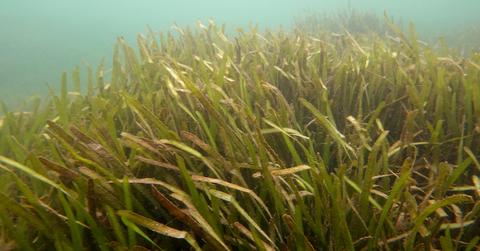Biggest Plant on Earth Discovered in Australia, Thanks to All-Natural Cloning
Published June 1 2022, 4:14 p.m. ET

Seagrass in the Homosassa River on Oct. 5, 2021 in Homosassa, Fla.
Someone get Guinness World Records on the phone, because the world’s biggest plant has been discovered in Australia!
A group of scientists has discovered the plant, which they believe began growing about 4,500 years ago from one single seed, thanks to some all-natural cloning — seriously.
Keep reading for the key details.
The world’s biggest plant was just discovered in Australia.
Australian scientists shared their findings on this impressive plant in a study, published on June 1, 2022 in the journal Proceedings of the Royal Society B: Biological Sciences.
For the study, the researchers studied organisms growing along Shark Bay in Western Australia; they explain that this area is known as a World Heritage Area, and it is abundant with temperate seagrass meadows, including the plant Posidonia australis, often referred to as Poseidon's ribbon weed.
In doing research for this study, the researchers discovered that approximately 4,500 years ago, one seed (which originated from two different species of seagrass) germinated; now, thousands of years later, the seed has grown into one singular Posidonia australis plant, measuring about 200 square kilometers (77 square miles) in size, as explained by The Guardian.
BBC News noted that the team of researchers studied around 18,000 genetic markers for this study, while author Dr. Elizabeth Sinclair of the University of Western Australia explained that they used genetic tools to make this startling discovery, as per CNN. In the end, the entire team was surprised to discover that a single seagrass plant had grown — via vegetative growth, as per the study — into something so mammoth. According to the study, the plant also measured at least 180 kilometers (about 112 miles) long.
"The answer definitely surprised us — just ONE! That's it, just one plant has expanded over 180 kilometers in Shark Bay, making it the largest known plant on Earth," Sinclair told CNN in a statement. She added that the plant seems to be “really resilient,” as it has thrived in an area with a wide range of temperatures, varying salinities (the water’s saltiness), and intense light conditions, Sinclair told BBC News.
“We thought ‘what the hell is going on here?’” stated Dr. Martin Breed of Flinders University, as per The Guardian. “We were completely stumped.”
“The existing 200 square kilometers of ribbon weed meadows appear to have expanded from a single, colonizing seedling,” added the University of Western Australia’s Jane Edgeloe in a statement.
The world’s biggest plant has grown so large thanks to cloning.
You read that right — cloning was at play here. However, this was no human-led Dolly the sheep situation. This was nature’s cloning.
As explained by CNN, Posidonia australis naturally creates “genetically identical offshoots,” essentially cloning itself. The study’s authors believe this is the “largest known example of a clone in any environment on Earth.”
It’s extremely rare for animals to clone themselves in nature, but it does occasionally happen amongst certain species of plants, as well as bacteria and fungi, as CNN noted.